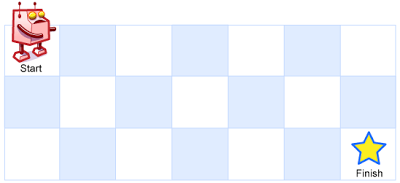Leetcode Day 29 - Dynamic Programming
62 Unique Paths | 63 Unique Paths II | 343 Integer Break | 96 Unique Binary Search Trees
Dynamic Programming
| Diff | Problem | Python | Java |
|---|---|---|---|
 | 62 Unique Paths | ✅ | |
 | 63 Unique Paths II | ✅ | |
 | 343 Integer Break | ✅ | |
 | 96 Unique Binary Search Trees | ✅ |
Unique Paths
here is a robot on an m x n grid. The robot is initially located at the top-left corner (i.e., grid[0][0]). The robot tries to move to the bottom-right corner (i.e., grid[m - 1][n - 1]). The robot can only move either down or right at any point in time.
Given the two integers m and n, return the number of possible unique paths that the robot can take to reach the bottom-right corner.
The test cases are generated so that the answer will be less than or equal to 2 * 109.
Example 1
Input: m = 3, n = 7
Output: 28
*Example 2**
Input: m = 3, n = 2
Output: 3
Explanation: From the top-left corner, there are a total of 3 ways to reach the bottom-right corner:
- Right -> Down -> Down
- Down -> Down -> Right
- Down -> Right -> Down
Solution
Python
1
2
3
4
5
6
7
8
9
10
11
12
13
14
class Solution(object):
def uniquePaths(self, m, n):
if m == 1 or n == 1:
return 1
grid = [[0] * n for _ in range(m)]
grid[0][0] = 1
for M in range(m):
for N in range(n):
if M != 0: grid[M][N] += grid[M - 1][N]
if N != 0: grid[M][N] += grid[M][N - 1]
return grid[-1][-1]
Unique Paths II
You are given an m x n integer array grid. There is a robot initially located at the top-left corner (i.e., grid[0][0]). The robot tries to move to the bottom-right corner (i.e., grid[m - 1][n - 1]). The robot can only move either down or right at any point in time.
An obstacle and space are marked as 1 or 0 respectively in grid. A path that the robot takes cannot include any square that is an obstacle.
Return the number of possible unique paths that the robot can take to reach the bottom-right corner.
The testcases are generated so that the answer will be less than or equal to 2 * 109.
Example 1
Input: obstacleGrid = [[0,0,0],[0,1,0],[0,0,0]]
Output: 2
Explanation: There is one obstacle in the middle of the 3x3 grid above.
There are two ways to reach the bottom-right corner:
- Right -> Right -> Down -> Down
- Down -> Down -> Right -> Right
Input: obstacleGrid = [[0,1],[0,0]]
Output: 1
Solution
Python
1
2
3
4
5
6
7
8
9
10
11
12
13
14
15
class Solution(object):
def uniquePathsWithObstacles(self, obstacleGrid):
if obstacleGrid[0][0] == 1 or obstacleGrid[-1][-1] == 1: return 0
m, n = len(obstacleGrid), len(obstacleGrid[0])
grid = [[0] * n for _ in range(m)]
grid[0][0] = 1
for M in range(m):
for N in range(n):
if obstacleGrid[M][N] == 1: continue
if M != 0: grid[M][N] += grid[M - 1][N]
if N != 0: grid[M][N] += grid[M][N - 1]
return grid[-1][-1]
Similar Questions
| Diff | Similar Questions | Python | Java |
|---|---|---|---|
 | 64 Minimum Path Sum5 | ||
 | 2304 Minimum Path Cost in a Grid6 | ||
 | 980 Unique Paths III7 |
Integer Break
Given an integer n, break it into the sum of k positive integers, where k >= 2, and maximize the product of those integers.
Return the maximum product you can get.
Example 1
Input: n = 2
Output: 1
Explanation: 2 = 1 + 1, 1 × 1 = 1.
Example 2
Input: n = 10
Output: 36
Explanation: 10 = 3 + 3 + 4, 3 × 3 × 4 = 36.
Solution
Solution 1: Dynamic Programming
Time complexity: O(n2)
1
2
3
4
5
6
7
8
9
10
11
12
13
class Solution(object):
def integerBreak(self, n):
if n == 2: return 1
if n == 3: return 2
dp = [0] * (n + 1)
dp[2], dp[3] = 2, 3
for i in range(4, n+1):
for j in range(1, i // 2 + 1):
dp[i] = max(dp[i], dp[j] * dp[i - j])
return dp[n]
Solution 2: Greedy
Time complexity: O(1)
The second solution uses a greedy algorithm. It directly breaks down n into as many 3’s as possible, aiming to maximize the product of the integer breakdown. This approach is based on a mathematical pattern, and it returns the maximum product directly by considering different cases.
By breaking down n, we can observe that the more we break n into 3’s, the larger the product becomes. However, there are two special cases to consider:
- When
n % 3 == 1: Splitting out a4is better than splitting out a1(i.e.,3 * 3 * 1 < 3 * 4). - When
n % 3 == 2: Directly multiplying by2yields the optimal product.
- If
nis a multiple of 3: We can completely breakninto3’s, and the maximum product is3 ** (n // 3). - If
n % 3 == 1: Since the remainder1would decrease the product, we adjust by removing one3and replacing it with4(because3 + 1 = 4). The maximum product in this case is3 ** ((n // 3) - 1) * 4. - If
n % 3 == 2: The remainder2can be directly multiplied, so the maximum product is3 ** (n // 3) * 2.
1
2
3
4
5
6
7
8
9
10
11
12
13
14
15
16
17
class Solution(object):
def integerBreak(self, n):
if n == 2: return 1
if n == 3: return 2
if n % 3 == 0: return 3 ** (n // 3)
if n % 3 == 1: return 3 ** ((n // 3) - 1) * 4
return 3 ** (n // 3) * 2
```python
class Solution(object):
def integerBreak(self, n):
if n == 2: return 1
if n == 3: return 2
if n % 3 == 0: return 3 ** (n // 3)
if n % 3 == 1: return 3 ** ((n // 3) - 1) * 4
return 3 ** (n // 3) * 2
Similar Questions
| Diff | Similar Questions | Python | Java |
|---|---|---|---|
 | 1808 Maximize Number of Nice Divisors10 |
Unique Binary Search Trees
Given an integer n, return the number of structurally unique BST’s (binary search trees) which has exactly n nodes of unique values from 1 to n.
Example 1
Input: n = 3
Output: 5
Example 2
Input: n = 1
Output: 1
Solution
Python
1
2
3
4
5
6
7
8
9
10
11
12
13
14
class Solution(object):
def numTrees(self, n):
if n == 1: return 1
if n == 2: return 2
dp = [0] * (n + 1)
dp[0],dp[1], dp[2] = 1, 1, 2
for i in range(3,n + 1):
for j in range((i - 1) // 2 + 1):
dp[i] += dp[j] * dp[i - j - 1] * 2 if j != i - j - 1 else dp[j] * dp[i - j - 1]
return dp[n]
Similar Questions
| Diff | Similar Questions | Python | Java |
|---|---|---|---|
 | 95 Unique Binary Search Trees II13 |
Reference
Leetcode-62 Unique Paths: https://leetcode.com/problems/unique-paths/description/. ↩︎
代码随想录-不同路径: https://programmercarl.com/0062.不同路径.html. ↩︎
Leetcode-63 Unique Paths II: https://leetcode.com/problems/unique-paths-ii/description/. ↩︎
代码随想录-不同路径II: https://programmercarl.com/0063.不同路径II.html. ↩︎
Leetcode-64 Minimum Path Sum: https://leetcode.com/problems/minimum-path-sum/description/. ↩︎
Leetcode-2304 Minimum Path Cost in a Grid: https://leetcode.com/problems/minimum-path-cost-in-a-grid/description/. ↩︎
Leetcode-980 Unique Paths III: https://leetcode.com/problems/unique-paths-iii/. ↩︎
Leetcode-343 Integer Break: https://leetcode.com/problems/integer-break/description/. ↩︎
代码随想录-整数拆分: https://programmercarl.com/0343.整数拆分.html. ↩︎
Leetcode-1808 Maximize Number of Nice Divisors: https://leetcode.com/problems/maximize-number-of-nice-divisors/. ↩︎
Leetcode-96 Unique Binary Search Trees: https://leetcode.com/problems/unique-binary-search-trees/description/. ↩︎
代码随想录-不同的二叉搜索树: https://programmercarl.com/0096.不同的二叉搜索树.html. ↩︎
Leetcode-95 Unique Binary Search Trees II: https://leetcode.com/problems/unique-binary-search-trees-ii/description/. ↩︎



